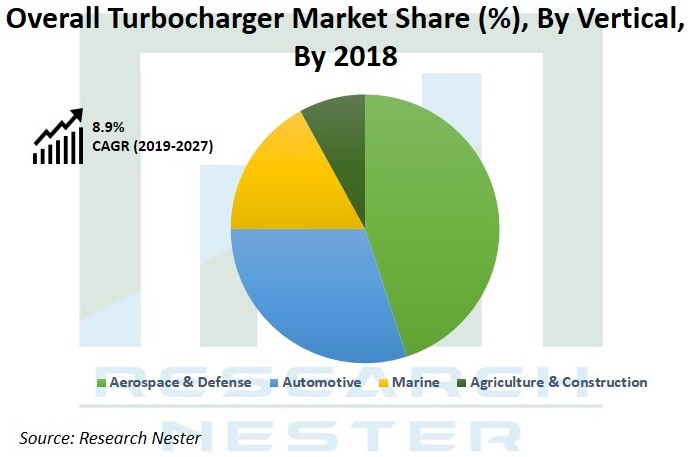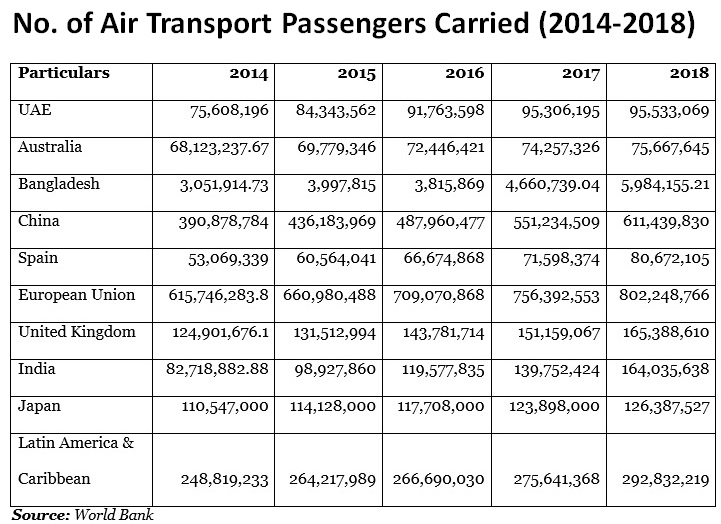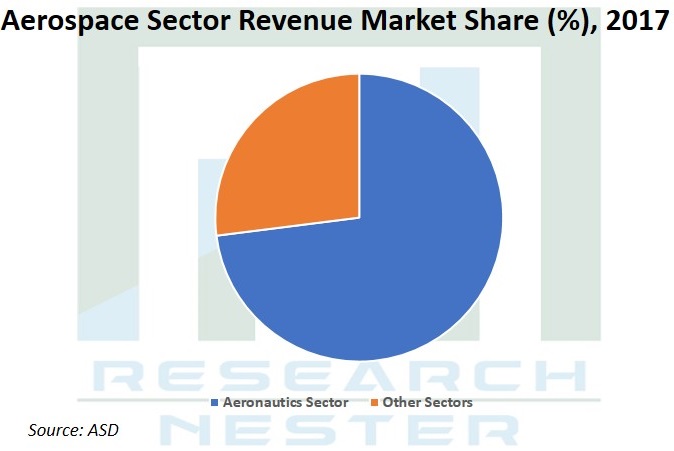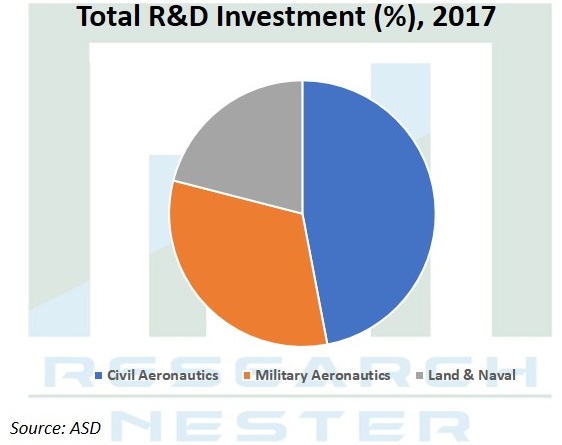Introduction to Turbochargers
Turbochargers or turbo, is a device used in internal combustion engines to increase the engine’s efficiency and power. It does that by forcing extra compressed air into the combustion chamber of the engine. Turbochargers differs from superchargers by their driven mechanism. Superchargers uses mechanically driven device and the former is driven by the engines exhaust gas. Although in comparison to superchargers, turbochargers tend to be more efficient, but less responsive, owing to the difference in their driven mechanism.
Market Size and Forecast
Rising demand for cost-effective and fuel-efficient engines in industries such as automotive, marine and aerospace & defense has led to higher adoption of turbochargers. The overall turbocharger market is observing vibrant growth on account of growing demand for energy-proficient engine to minimize atmospheric pollution. Furthermore, growing demand for downsizing of engines for optimizing emission levels and meet the emission norms of various economies, is slated to drive the growth of the overall turbocharger market.
The market is anticipated to grow at a CAGR of around 8.9% throughout the forecast period, i.e. 2019-2027. The overall turbocharger market is segmented by verticals into aerospace & defense, automotive, marine and agriculture & construction, out of which, aerospace & defense segment is anticipated to have largest market share on the back of growing need for downsized engines to meet the demand of rising production of aircrafts in the civil and military aeronautics division. Furthermore, growing investments for research and developments in the industry, for the need of improvised efficiency in engines, is anticipated to act as an add-on factor to the growth of the overall turbocharger market. Moreover, the automotive turbochargers market segment is also anticipated to gain significant market on the back of increased stringency in the emission norms taken by government.

Get more information on this report: Download Sample PDF
Growth Drivers
Rising Strides For Lowering Emissions In Civil Aviation
There is an increasing global demand for mobility which is adding to the growth of the aviation industry. According to The World Bank, between 1998 and 2017, air transport passengers of the world grew substantially from 1466 million to 3978 million.
 Growing flight mobility have also contributed to the rise in number of civil aircrafts, resulting in the surge in revenue of the overall aerospace industry. According to the Aerospace and Defence Industries Association of Europe (ASD), the country observed continuous growth in the aeronautics sector of the aerospace industry for the year 2017 with revenue increasing by 3.3% and accounting to 73% of the total industry revenue.
Growing flight mobility have also contributed to the rise in number of civil aircrafts, resulting in the surge in revenue of the overall aerospace industry. According to the Aerospace and Defence Industries Association of Europe (ASD), the country observed continuous growth in the aeronautics sector of the aerospace industry for the year 2017 with revenue increasing by 3.3% and accounting to 73% of the total industry revenue.

Surge in the aerospace industry is also contributing significantly to the raising concerns for environmental deterioration. According to the United States Environmental Protection Agency (EPA), an aircraft accounted for 12% of all U.S. transportation greenhouse gas (GHG) and 3% of total U.S. GHG. Moreover, the International Civil Aviation Organization (ICAO) stated that the total CO2 aviation emissions was approximately 2% of the global greenhouse emissions.
All of these factors have drawn advantages for extensive usage of turbochargers in the production of the aircraft engines by downsizing them and replacing old engine aircrafts with newer ones, so as to reduce global carbon emissions, GHG and nitrogen oxides (NOx) emissions.
Rising Investments For Research And Development In The Aviation Industry
According to the Aerospace and Defence Industries Association of Europe (ASD), investments in research and development in the civil aeronautics industry of Europe was around 47% of the overall investment for the year 2017.

In America, according to the Aerospace Industries Association (AIA), government R&D spending relevant to aerospace and defense in the year 2017 grew by 7.5% to $84.7 billion, and industry R&D from the top 25 aerospace and defense firms grew by 8.7% to $18.1 billion for the same year.
Riding on the back of these statistical data, investments for R&D have grown multifold in the aerospace and defense industry. Growing need for technological advances in the development of highly proficient engines for the aerospace industry is anticipated to support the growth of the overall turbocharger market throughout the forecast period.
Restraints
High Product Cost Of Turbochargers
Rising technological advancements in the rapid changing technology of engines have also led to the usage of variety of raw materials for the manufacturing of turbochargers. Fluctuating price of volatile raw materials is increasing the cost of production, which is estimated to act as a barrier to the growth of the overall turbo charger market during the forecast period.
Market Segmentation
Our in-depth analysis of the overall turbocharger market includes the following segments:
By Technology
- Twin Turbo Technology
- Wastegate Technology
- Variable Geometry or Nozzle Technology
By Fuel Type
- Gasoline
- Petrol
- Diesel
By Distribution Channel
- OEM
- Aftermarket
By Verticals
- Aerospace & Defense
- Automotive
- Marine
- Agriculture & Construction
By Region
On the basis of regional analysis, the overall turbocharger market is segmented into major regions including North America, Europe, Asia Pacific, Latin America and Middle East & Africa region.
North America is expected to have largest market share on the back of growing demand for downsizing of engines owing to stringent norms for lowering carbon footprint and greenhouse gas emissions. Furthermore, growing investments for R&D in various industries combined with presence of key players of aerospace industry is anticipated to boost the growth of the market in the region.
The overall turbocharger market is further classified on the basis of region as follows:
- North America (U.S. & Canada) Market size, Y-O-Y growth & Opportunity Analysis
- Latin America (Brazil, Mexico, Argentina, Rest of Latin America) Market size, Y-O-Y growth & Opportunity Analysis
- Europe (U.K., Germany, France, Italy, Spain, Hungary, Belgium, Netherlands & Luxembourg, NORDIC, Poland, Turkey, Russia, Rest of Europe) Market size, Y-O-Y growth & Opportunity Analysis
- Asia-Pacific (China, India, Japan, South Korea, Indonesia, Malaysia, Australia, New Zealand, Rest of Asia-Pacific) Market size, Y-O-Y growth & Opportunity Analysis.
- Middle East and Africa (Israel, GCC (Saudi Arabia, UAE, Bahrain, Kuwait, Qatar, Oman), North Africa, South Africa, Rest of Middle East and Africa) Market size, Y-O-Y growth & Opportunity Analysis.
Top Featured Companies Dominating the Market
- BorgWarner Turbo Systems
- Company Overview
- Business Strategy
- Key Product Offerings
- Financial Performance
- Key Performance Indicators
- Risk Analysis
- Recent Development
- Regional Presence
- SWOT Analysis
- Honeywell International Inc.
- Mitsubishi Heavy Industries Ltd.
- IHI Corporation
- Continental AG
- Cummins Inc.
- Eaton
- BMTS technology
- Precision Turbo & Engine
- Rotomaster International

